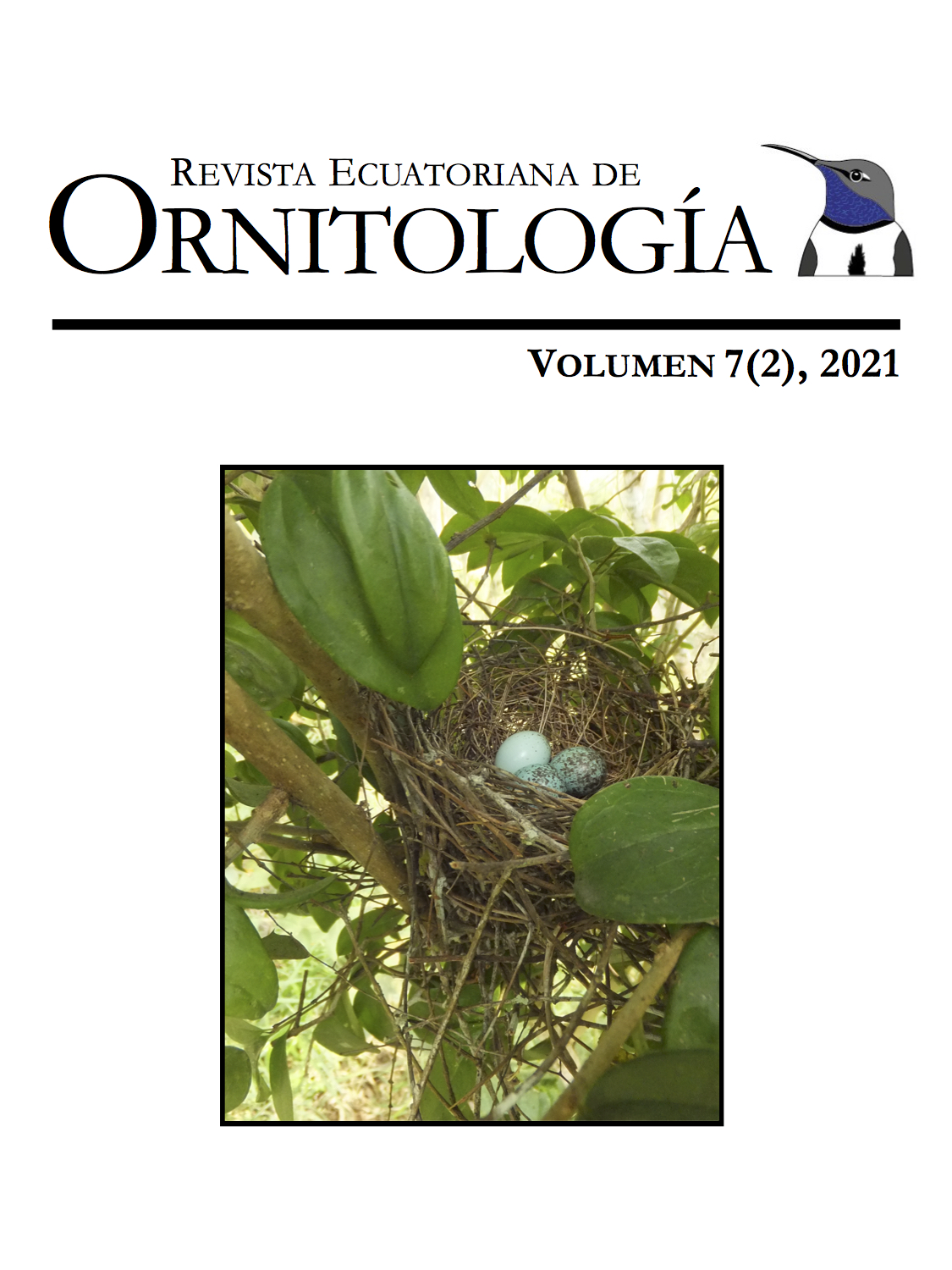NOTAS SOBRE LA ARQUITECTURA DEL NIDO, PICHONES Y DESCRIPCIÓN ACÚSTICA DEL LLAMADO DEL GALLINAZO NEGRO Coragyps atratus (CATHARTIDAE) EN EL ESTE Y OESTE DE LOS ANDES DE ECUADOR
DOI:
https://doi.org/10.18272/reo.v7i2.2308Keywords:
bioacústica, comportamiento, Coragyps atratus, llamado, pichones, nidos, reproducción, vocalizaciónAbstract
This communication includes the description of two nests at two different stages of the nestlings of Black Vulture Coragyps atratus on each side of the Ecuadorian Andes. We show the defensive behavior of nestlings in the face of human presence. Finally, we conducted a bioacustics analysis and graphic representation of the calling obtained from the western nestlings. In general, our observations support previous reports of the seasonal biology of C. atratus reproduction in South America.
Downloads
References
Alvarado-Orellana, S., Figueroa-Rojas, R., Valladares, P., Carrasco-Lagos, P., & Moreno-Morales, R. (2015). Aves rapaces de la Región Metropolitana de Santiago, Chile. Santiago, Chile: Ministerio del Medio Ambiente.
Antas, P.T.Z. (2004). Pantanal - Guia de aves: espécies de aves da Reserva do Patrimônio Natural do SESC Pantanal. Rio de Janeiro, Brasil: Serviço Social do Comércio SESC, Departamento Nacional.
Belenguer, C., & Zalba, S.M. (1997). Primera cita de nidificación del Jote de Cabeza Negra (Coragyps atratus) para Buenos Aires. El Hornero, 14(4), 247-248. URL:
http://hdl.handle.net/20.500.12110/hornero_v014_n04_p247
Buckley, N.J. (2020). Black Vulture (Coragyps atratus), version 1.0. In A.F. Poole & F.B. Gill (Eds), Birds of the World. Ithaca, NY: Cornell Lab of Ornithology. DOI: https://doi.org/10.2173/bow.blkvul.01
Center for Conservation Bioacustics. (2019). Raven Lite: interactive sound analysis software (Version 2.0). Ithaca, NY: The Cornell Lab of Ornithology. URL: http://www.birds.cornell.edu/raven.
Climate-Data. (2021a). Clima Santo Domingo (Ecuador). URL: https://es.climate-data.org/america-del-sur/ecuador/santa-elena-province/santo-domingo-228128/
Climate-Data. (2021b). Clima Yasuní (Ecuador). URL: https://es.climate-data.org/america-del-sur/ecuador/provincia-de-orellana/yasuni-181639
De Lucca, E. (2016). Reproducción del Jote Cabeza Negra (Coragyps atratus) en un nido construido por loros barranqueros (Cyanoliseus patagonus) en un acantilado del litoral patagónico, Argentina. Nótulas Faunísticas, segunda serie, 194, 39-44. URL: https://www.fundacionazara.org.ar/img/notulas-faunisticas/articulos/notula-194.pdf
Di Giácomo, A. G. (2005). Aves de la Reserva El Bagual. En A.G. Di Giácomo & S. Krapovickas (Eds), Historia natural y paisaje de la Reserva El Bagual, provincia de Formosa, Argentina. Buenos Aires, Argentina: Aves Argentinas, Temas de Naturaleza y Conservación.
Freile, J., & Restall, R. (2018). Birds of Ecuador. London, Reino Unido: Helm Field Guides.
Hill, J.R., & Neto, P.S. (1991). Black vultures nesting on skyscrapers in southern Brazil. Journal of Field Ornithology, 62(2), 173-176. URL: https://sora.unm.edu/sites/default/files/journals/jfo/v062n02/p0173-p0176.pdf
Hill, R., & Greeney, H.F. (2000). Ecuadorian birds: nesting records and eggs descriptions from a lowland rainforest. Avicultural Magazine, 106, 49-53. URL: https://scholarlycommons.pacific.edu/cop-facarticles/513
Mainwaring, M.C., Hartley, I.R., Lambrechts, M.M., & Deeming, D.C. (2014). The design and function of birds"™ nests. Ecology and Evolution, 4(20), 3909-3928. DOI: https://doi.org/10.1002/ece3.1054
Maurício, G.N., Bencke, G.A., Repenning, M., Machado, D.B., Dias, R.A., & Bugoni, L. (2013). Review of the breeding status of birds in Rio Grande do Sul, Brazil. Iheringia, 103(2), 163-184. URL: https://www.scielo.br/j/isz/a/GyGYhLZVnhqQGqThcRcYMgn/?lang=en&format=pdf
McClure, C.J.W., Westrip, J.R.S., Johnson, J.A., Schulwitz, S.E., Virani, M.Z., Andrew, R.D., Wheatley, H., Thorstrom, R., Amar, A., Buij, R., Jones, V.R., Williams, N.P., Buechley, E.R., & Butchart, S.H. (2018). State of the world's raptors: Distributions, threats, and conservation recommendations. Biological Conservation, 227, 390-402. DOI: https://doi.org/10.1016/j.biocon.2018.08.012.
Monsalvo, J.M., Marcelo, S., Neander, H., & Miguel, M. (2020). Geographical variation and current knowledge on breeding traits of vultures in the neotropics. Ornithology Research, 28, 13-37. DOI: https://doi.org/10.1007/s43388-020-00003-4
Montiel-Herrera, M., & Gallo-Reynoso, J.P. (2013). Behaviors of nestling and juvenile Black Vultures in Northwestern Mexico. Western Birds, 44(4), 316-318. URL: https://archive.westernfieldornithologists.org/archive/V44/WB-44(4)-Herrera-Reynoso.pdf
Ocenaudio Development Team. (2015). Ocenaudio 3.0. Universidad Federal de Santa Catarina, Brasil. URL: https://www.ocenaudio.com/pt/whatis
Ridgely, R.S., & Greenfield, P.J. (2006). Aves del Ecuador. Volumen II, guía de campo Quito, Ecuador: Academia de Ciencias Naturales de Filadelfia & Fundación de Conservación Jocotoco.
Ríos, C. (2014). Bioecología del Coragyps atratus "gallinazo" en la zona del distrito de Belén-Perú (Tesis de Ingeniería). Universidad Nacional de la Amazonía Peruana, Belén, Perú. URL: https://docplayer.es/40904222-Bioecologia-del-cor-agyps-atratus-gallinazo-en-la-zona-del-distrito-de-belen-peru.html
Terres, J.K. (1980). The Audubon Society encyclopedia of North American birds. New York: Alfred A. Knopf.
Valladares, P., Alvarado, S., Urra, C., Abarca, J., Inostroza, J., Codoceo, J., & Ruz, M. (2013). Cadmium and lead content in liver and kidney tissues of wild Turkey Vulture Cathartes aura (Linneo, 1758) from Chañaral, Atacama Desert, Chile. Gayana, 77, 97-104. DOI: http://dx.doi.org/10.4067/S0717-65382013000200004
Varela, S. (2021, Febrero 6). XC638575 Black Vulture, Coragyps atratus. Xeno-Canto. URL: https://www.xeno-canto.org/638575
von Ihering, H. (1900). Catalogo critico-comparativo dos ninhos e ovos das aves do Brazil. Revista Museu Paulista, 4, 191-300.
Downloads
Published
How to Cite
Issue
Section
License
Los autores que publiquen en la Revista Ecuatoriana de Ornitología aceptan los siguientes términos:
- Los autores/as conservarán sus derechos de autor y garantizarán a la revista el derecho de primera publicación de su obra, el cuál estará simultáneamente sujeto a la Licencia de Reconocimiento No Comercial de Creative Commons.
- Los autores/as podrán adoptar otros acuerdos de licencia no exclusiva de distribución de la versión de la obra publicada, pudiendo de esa forma publicarla en un volumen monográfico o reproducirla de otras formas, siempre que se indique la publicación inicial en esta revista.
- Se permite y se recomienda a los autores difundir su obra a través de Internet en su repositorio institucional, página web personal, o red social científica (como ResearchGate o Academia.edu).


